
Jack Janetzki
Quality Use of Medicines and Pharmacy Research Centre, University of South Australia
Learn more opens in a new windowProject Incubator Program

This study aims to explore the application of TreeScan in Australian post-market surveillance of adverse drug events. TreeScan is a data-driven approach for signal detection of adverse drug events that can be implemented on longitudinal datasets. TreeScan can be utilised to identify adverse drug events at a broad level (for example seizures) and also at a more granular level (for example specifically febrile seizures). It can also identify whether medicines are associated with risk of adverse events at a class level or at an individual medicine level. As such, TreeScan can report on the risk of adverse events at both broad and specific levels, evaluate many events or groups of events simultaneously, and adjust for multiple testing to minimize false positive signals.
To determine the utility of TreeScan in the Australian setting we aim to first validate the methodology by conducting a sensitivity and specificity analysis of SGLT2 inhibitors and confirm risk of known adverse events. Subsequently we will be able to apply TreeScan to other drugs and adverse events of interest. Expanding on this analysis, we will then use TreeScan methodology to understand the risk of adverse drug events in populations of people using SGLT2 inhibitors for different indications (such as Type 2 diabetes, heart failure and chronic kidney disease) to determine whether the risk profile of the SGLT2 inhibitors differs depending on the condition they are being used to treat. As such we will be able to highlight which populations may be at risk of certain adverse events.
Jan 2023 - Jul 2024
Prof Nicole Pratt - University of South Australia
Dr Lan Kelly - University of South Australia
Dr Juliana de Oliveira Costa - UNSW Sydney
Ms Ximena Camacho - UNSW Sydney
Dr Michael Falster - UNSW Sydney
Prof Sallie Pearson - UNSW Sydney
1) Can TreeScan be utilised in the Australian post-market surveillance setting (case-study: monitoring SGLT2 inhibitors and identify all known adverse drug events associated with use of SGLT2 inhibitors)?
2) Are the risks of SGLT2s modified by indication (e.g Type 2 diabetes mellitus, chronic kidney disease or heart failure)?
The primary data source that will be utilised to address these aims is the Medicines Intelligence Data Platform (MIDP). MIDP will allow for characterisation of the study population to assess treatment indication, comorbidities and outcomes, as opposed to using claims databases such as the PBS10% sample.
The significance of this project lies in its potential to enable the TGA to identify the risk of adverse drug events in different populations who are using the same medication for different indications.
The insights gained from this analysis will enable clinicians to make more informed prescribing decisions, especially for high-risk population groups. Additionally, clinicians may be reassured that new populations for whom a medicine is indicated are not exposed to additional risks beyond those that are already known.
There is also the potential to establish an active monitoring system that will allow for rapid identification of adverse drug event signals when medicines are approved for expanded indications and taken by new populations.
This section will be updated throughout the project. Please return in the future to see the impact from this project.